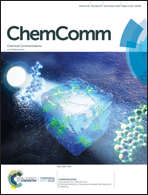Synergistic bimetallic CoFe2O4 clusters supported on graphene for ambient electrocatalytic reduction of nitrogen to ammonia†
Abstract
The energy-intensive nature, high level of CO2 emission and sophisticated infrastructure requirement hampered the utilization of the Haber–Bosch process as a green and decentralized system for NH3 production. The electrochemical N2 reduction reaction (NRR) provides a promising alternative to fix N2 under ambient conditions. Here, we report CoFe2O4 nanoclusters anchored on reduced graphene oxide for enhanced nitrogen reduction. In contrast to monometallic counterparts, this composite catalyst achieves a faradaic efficiency of 6.2% with a high rate of NH3 production of 4.2 × 10−11 mol s−1 cm−2 in 0.1 M Na2SO4 aqueous electrolyte. Amelioration of NRR performance could be attributed to the availability of different types of adsorption and active sites for N2 after the incorporation of Co in the Fe3O4 structure. Also, the homogeneous dispersion of nanoclusters on a 2D support can achieve higher active site density. This work provides a new category of binary metal oxides catalysts for NRR under ambient conditions.



 Please wait while we load your content...
Please wait while we load your content...